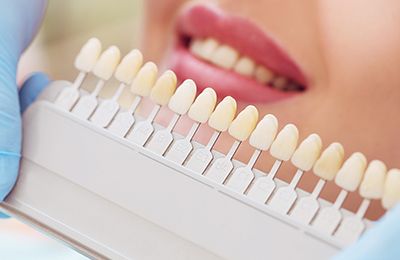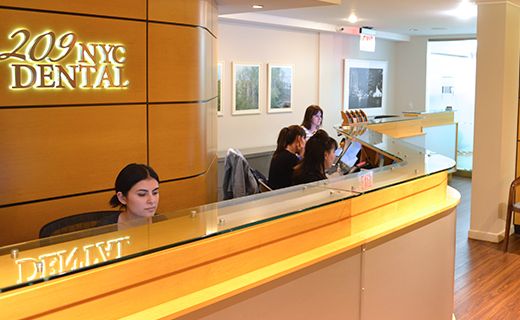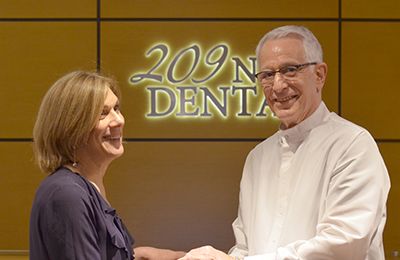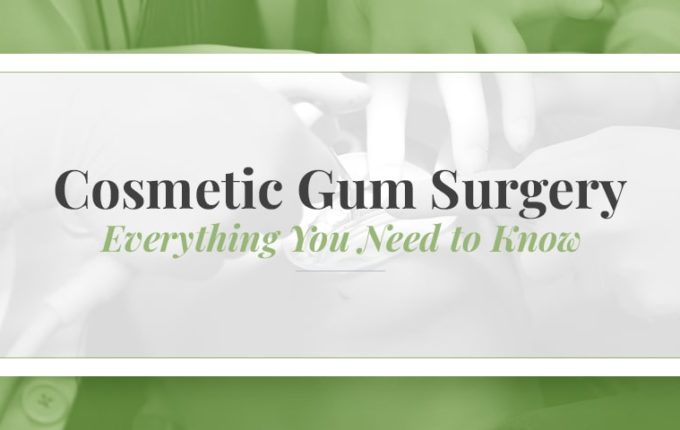Gum Disease: A Silent Threat to Your Health

Did you know that according to the American Dental Association gum disease affects almost 50% of adults in the US? This silent disease is often overlooked and can have serious consequences to your overall health. In this article we will go over gum disease information, causes, symptoms, risk factors and treatment for periodontal disease, and why you should see an expert when symptoms appear. 209 NYC Dental offers a range of periodontal treatments performed by our board certified periodontists.
What is Gum Disease?
Gum disease, also known as periodontal disease, is a common dental disease that affects the gums and bone surrounding teeth.
It starts when plaque, a sticky bacterial film, forms on your teeth and if not removed during brushing it hardens into tartar. A regular dental cleaning with a hygienist is necessary to prevent tartar buildup and maintain healthy teeth and gums. As tartar builds up it irritates the gums, causing puffy gums and inflammation.
As the infection gets worse the gums recede, forming pockets that trap bacteria. This is called “pocket formation”. Your doctor or hygienist measures pockets with a periodontal probe, a “dental ruler” with 1mm gradations. In a healthy patient we find 1mm-3mm of space between the tip of the gum and where the gum attaches to the bone. As periodontal disease advances we see 5mm-7mm of pockets which severely compromises the health, stability and ultimately the retention of the tooth.
As the pockets get bigger they get infected, causing loose or sensitive teeth and more gum tissue and bone destruction. Which can also change the way your teeth fit together when you bite.
If left untreated periodontal disease can progress and lead to tooth loss.
To prevent or manage periodontal disease you need to maintain good oral hygiene and see a dental hygienist for regular cleanings and check-ups.
Symptoms of Gum Disease
Early signs of gum disease like gingivitis can be subtle and go unnoticed. However, as the disease progresses, the signs become more noticeable. Keep an eye out for these red flags:
- Bleeding gums: This is an early sign of periodontal disease. Even gentle brushing can cause bleeding.
- Swollen, red, or tender gums
- Persistent bad breath: Gum disease can cause bad breath that lingers even after you brush and floss.
- Receding gums: Gum tissue can pull away from your teeth, exposing roots.
- Pain or discomfort when chewing: Periodontal disease can cause sensitivity and pain when eating due to exposed roots .
- Changes in bite: As teeth loosen and move, your bite can shift.
- Loose teeth: As bone loss progresses, teeth can become loose.
If you see any of these symptoms, see a dentist or periodontist for an exam and treatment.

Front teeth with sever bone loss
The Importance of Gum Health
Gum health is key to overall oral health and preventing periodontal disease. Healthy gums are firm, pink and fit snugly around the teeth. They support the teeth and protect the underlying bone and tissue. When gums are healthy it helps:
- Stop plaque and bacteria from building up on the teeth: Healthy gums act as a barrier against bad bacteria. In addition, if not removed, plaque can cause tooth decay.
- Prevent gum recession: Receding gums are ugly but more insidiously they are a precursor to dental pathology such as root caries and periodontal gum disease.
- Reduce the risk of periodontal disease and loose teeth.
- Support the teeth and keep them in place: They provide the support to keep teeth where they should be.
- Improve the smile: Healthy pink gums = beautiful smile.
Types of Periodontal Diseases
Gum disease, a silent yet potent threat to oral health. It progresses through distinct stages. Knowing these stages is key to early detection and intervention.
Gingivitis
The first stage of gum disease is called gingivitis. It causes inflamed, red tender and swollen gums. This inflammation is a response to bacterial plaque, a sticky film that forms on your teeth. Gingivitis is the mildest form of periodontal gum disease but it can progress to a more serious stage if left untreated.
Periodontitis
Periodontitis is a more advanced form of periodontal disease that involves the destruction of the tissues supporting the teeth. As the infection deepens, it begins to erode the bone that holds teeth in place. This can lead to a variety of dental issues, including:
- Pocket Formation and Bleeding Gums: As the gums recede, pockets form between the teeth and gums. These pockets harbor bacteria, making them difficult to clean. Bleeding gums often accompany this stage, serving as a warning sign of periodontal disease.
- Bone Loss: The destructive nature of periodontitis can lead to significant bone loss of bone, weakening the teeth and making them more susceptible to loosening.
- Tooth Loss: In severe cases, periodontitis can result in tooth loss.
Periodontitis can be further categorized into stages to assess its severity and guide appropriate professional treatment. Based on the severity of bone and tissue damage Periodontitis cab classified from Mild Periodontitis to Advanced.
It’s important to note that the progression of periodontitis can vary from person to person. Factors such as dental hygiene practices, systemic health conditions, and genetic predisposition can influence the rate of disease progression. Early detection and prompt treatment are crucial to prevent the disease from worsening and to preserve dental health.
If you notice any warning signs of periodontal disease don’t hesitate to schedule a consultation with 209 NYC Periodontists. Early diagnosis and professional treatment can stave off progression of gum disease and help maintain your oral health.
Risk Factors for Gum Disease
Gum disease can affect anyone, but certain risk factors increase the likelihood of developing the condition. These include:
- Poor oral health: Neglecting regular brushing and flossing can lead to plaque buildup.
- Misaligned teeth: Crowded and crooked teeth, spaces between teeth, and other dental misalignments can create hard-to-reach areas in your mouth. These spaces often become breeding grounds for plaque and bacteria, increasing the risk of poor oral hygiene.
- Smoking: Tobacco use is a significant risk factor for gum disease.
- Diabetes: High blood sugar levels can contribute to periodontal disease.
- Heart disease: There is a link between gum disease and cardiovascular conditions.
- Obesity: Excess weight can increase the risk of periodontal disease.
- Stress: Chronic stress can weaken the immune system, making it harder to fight infections.
- Hormonal changes: Pregnancy, menopause, and other hormonal changes can affect gum health.
- Genetics: A family history of gum disease can increase your risk.
- Age: Gum disease is more common among adults over 30.
- Certain medications: Steroids and certain antidepressants can affect gum health.
According to the Centers for Disease Control and Prevention (CDC), about 47% of adults in the US have some form of periodontal disease. 9% of whom have severe gum disease. It is more prevalent among smokers, diabetics, and obese individuals.
Gum Disease Treatment with 209 NYC Periodontists
Our experienced board-certified periodontists offer a range of Periodontics procedures in NYC to treat gum disease. In addition to traditional treatment methods, our NYC periodontist also offers advanced techniques to combat periodontal disease:
Nonsurgical Treatment
Scaling and Root Planing (SRP): Also known as deep cleaning SRP removes plaque and tartar from both above and below the gum line. By smoothing the tooth’s root surface, deep cleaning helps prevent tartar buildup and promotes gum healing.
Laser Therapy: Laser therapy is a minimally invasive procedure that uses laser energy to kill bacteria and stimulate tissue healing.
Antibiotic Therapy: In some cases, antibiotics may be prescribed to target specific bacteria associated with periodontal disease.
Surgical Procedures
Osseous Surgery or Flap surgery: This surgical procedure is designed to reshape and repair bone tissue that has been damaged by periodontal disease. By removing diseased tissue and reshaping the bone around the affected teeth, osseous surgery can help create a healthier environment for gums to heal.
Bone Graft: Bone grafting is a surgical procedure that involves replacing lost bone with bone graft, The doctor can use own bone, donner bone or a synthetic bone. This procedure can help to regenerate bone and support tooth structure.
Soft tissue grafts: Soft tissue grafts are a surgical procedure used to address gum recession. During this procedure, our specialist takes tissue from another area of your mouth, often the palate, and grafts it onto the affected area. This helps cover exposed roots, reduce sensitivity, and prevent further gum recession.
By combining these treatment options with a comprehensive approach to dental hygiene, 209 NYC Dental can help you achieve optimal dental health and a beautiful smile.
The Risks of Untreated Gum Diseases
Gum disease is a significant public health concern, affecting millions of people worldwide. According to the CDC, it is the leading cause of tooth loss among adults in the United States. Research has shown that periodontal gum disease has other risk factors and is linked to various systemic health conditions, including:
- Coronary artery disease: Gum disease can increase the risk of heart disease.
- Diabetes: There is a bidirectional relationship between gum disease and diabetes.
- Respiratory infections: Infections in the gums can contribute to respiratory problems.
- Rheumatoid arthritis: Chronic inflammation from gum disease can exacerbate arthritis.
- Stroke: Gum disease has been associated with an increased risk of stroke.
- Premature birth and low birth weight
The American Dental Association (ADA) estimates that gum disease costs the United States healthcare system over $50 billion annually. The National Institute of Dental and Craniofacial Research (NIDCR) conducts extensive research on gum disease to better understand its causes, symptoms, and treatment options.
How to Prevent Gum Disease and Reverse Gingivitis
While gum disease can be managed effectively in many cases, prevention is always the best approach. By incorporating proper daily oral hygiene habits into your routine, you can significantly reduce your risk of developing gum disease and even reverse gingivitis. Reversing gingivitis, the mildest form of gum disease, is possible with consistent and effective oral hygiene practices.
- Brush Your Teeth Properly: Brush your teeth twice daily using a soft-bristled toothbrush and fluoride toothpaste, paying special attention to the gum line to fight plaque accumulate.
- Floss Daily: Floss can access areas where toothbrush cannot, like tight spaces between teeth and close to the gum line reach. Make it a habit to floss every night before bed.
- Use an Antiseptic Mouthwash to reduce bacteria and maintain gum health. Look for a mouthwash with the American Dental Association (ADA) Seal of Acceptance.
- A Healthy Diet rich in fruits, vegetables, and whole grains can support your immune system. Limit sugary snacks and drinks, as sugar can contribute to plaque build-up.
- Drink plenty of water, it helps wash away food particles and bacteria reducing the risk of gingivitis.
- Avoid tobacco products, as they increase the risk of gum disease.
- Visit your dentist regularly for dental cleaning to professionally remove plaque and tartar buildup. Your dentist or dental hygienist can detect early signs of gingivitis.
If detected and treated early by following these steps, gingivitis can be successfully reversed and prevented from progressing to periodontitis.
Visit 209 NYC Dental and Experience the Difference
At 209 NYC Dental, we’re committed to providing exceptional periodontal care to patients in New York City. Our board-certified periodontist, Dr. Jin Wang, brings decades of experience and expertise to every patient.
Whether you’re dealing with gum problems, missing teeth, or any other dental condition, our multi-specialty team is here to help.
- We offer a comprehensive range of dental services, including non-surgical treatments and surgical treatments: Scaling and Root Planing, Guided tissue regeneration, Dental Implants, Bone Grafting, Soft Tissue Graft.
- Convenient Appointments: Our dental office is open 7 days a week to accommodate your busy schedule.
- Dental Insurance: Our dentists accept most PPO dental insurance plans, making it easier to access the care you need.
- Reputation: We have thousands reviews across the internet about the amazing dental care we provide.
We encourage you to schedule a consultation with a 209 NYC Dental gum specialist if you experiencing any symptoms of periodontal disease or have concerns about your periodontal health. Our experienced periodontist can provide a comprehensive evaluation, go over gum disease information, diagnose any underlying issues, and recommend the most appropriate treatment plan.
Remember, a healthy smile starts with healthy mouth. Take control of your health today and schedule your appointment with Periodontics NYC.
Contact us today to schedule a consultation.
FAQ
Is periodontal disease contagious?
No, periodontal disease is not contagious. It is primarily caused by poor oral hygiene and the buildup of plaque and tartar on the teeth. While the bacteria that contribute to gum disease can be spread through saliva, the disease itself is not directly transmitted from person to person. Keeping your teeth and gums clean is the key to preventing and managing periodontal disease.
Is Gum Disease Curable?
Gum disease is not curable, but it is manageable with appropriate treatment. Once structural support around teeth is lost as in case of periodontitis, it usually cannot be regained. With proper treatments and good oral hygiene, it is possible to prevent further damage and maintain stable gums and teeth. However, gingivitis can be reversed with professional dental cleanings and diligent at-home oral hygiene routine.
By understanding the nature of periodontal disease and taking proactive steps to maintain healthy mouth, you can significantly reduce the risk of severe complications and enjoy a healthy smile for years to come.
 Our History
Our History
 Our Providers
Our Providers
 About Us
About Us
 Blog
Blog
 Contact us
Contact us
 Diagnostic & Preventive
Diagnostic & Preventive
 Implant Dentistry
Implant Dentistry
 Clear Braces - Invisalign
Clear Braces - Invisalign
 Cosmetic Dentistry
Cosmetic Dentistry
 Periodontics
Periodontics
 Patient Forms
Patient Forms
 Payment Information
Payment Information
 Insurance Options
Insurance Options
 CareCredit Dental
CareCredit Dental
 Appointment Policy
Appointment Policy
 Free Consultation
Free Consultation
 Complimentary Teeth Whitening
Complimentary Teeth Whitening
 Teeth Whitening
Teeth Whitening








